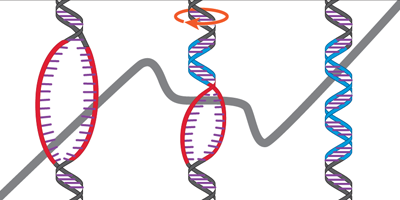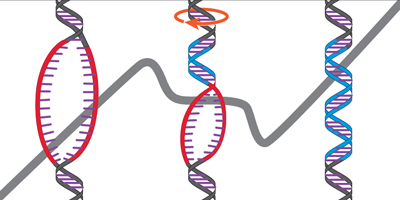Wind-up DNA
In biological processes such as replication and transcription, DNA’s double helix is unwound and separated so that it can act as a template for making new strands of DNA or RNA. To understand these maneuvers, researchers need to know the details of DNA’s mechanical behavior, in particular how it responds to an applied torque. But available torque-measurement techniques are typically only able to probe this behavior averaged over long strands of DNA. As reported in Physical Review Letters, Florian Oberstrass at Stanford University and colleagues are now able to measure, with unprecedented resolution, the response of specific base-pair sequences when a DNA strand is twisted.
The authors anchored one end of a DNA molecule to a magnetic bead that they could twist to wind or unwind the molecule. A second nanoscale bead, attached above a specific DNA sequence, was used to monitor the ensuing rotation at that site. As they twisted the molecule, the authors observed two different structural changes that are known to depend on the DNA sequence. The weakest DNA sequences (those containing only adenine and thymine base pairs) were found, under certain conditions, to open and close in alternation. The phenomenon, known as DNA “breathing,” is thought to be central in numerous physiological processes. In contrast, winding a DNA sequence based on alternating guanine and cytosine resulted in a structural transition, whereby right-handed DNA (B-DNA) turned into a left-handed configuration (Z-DNA).
The authors were able to describe both strand separation and the right- to left-handed transition with a simple model analogous to a one-dimensional chain of atomic spins. Further characterization of other sequences may lead to a more complete mechanical and thermodynamical model of DNA. – Matteo Rini





